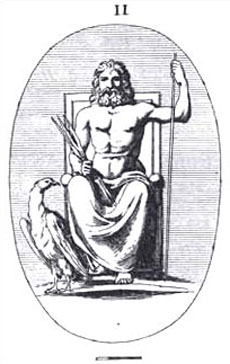2.6 The portrayal of traditional symbols of power
Napoleon on his Imperial Throne is crammed with traditional symbols of power. The sceptre surmounted by a statuette, the other sceptre (the ‘hand of justice’) and the sword all had associations with Charlemagne. In the run-up to the coronation, the regime had adopted as official propaganda the flattering notion of Napoleon as a modern Charlemagne (which was already current, as we have seen from David's portrait). Much effort was expended on legitimating his imperial authority by linking him to the last emperor to unite western Europe under his rule. The hand of justice, which had supposedly belonged to Charlemagne, was in fact fabricated for Napoleon's coronation. The great advantage of the early medieval monarchs as a source of legitimation was their remoteness from the Bourbon dynasty deposed by the Revolution. Another Carolingian (the Frankish dynasty founded by Charlemagne (d.814)) (and ancient Roman) symbol of power appropriated by Napoleon was the imperial eagle, which appears carved on to the throne and woven into the carpet in Ingres's painting. The eagle was originally an attribute of Jupiter, the king of the gods in classical mythology, and Ingres may have based Napoleon's pose on an image of the god which itself derived ultimately from a famous lost statue, known as the Olympian Jupiter, by the ancient Greek sculptor Phidias (see Figure 3). However, the pose could have come from any number of ancient or medieval depictions of enthroned figures. The crucial point is that it symbolized divine power and, when used for an earthly ruler, signified a divine right to rule.

When the painting was exhibited at the Salon, the main complaint was that it looked ‘gothic': that is, medieval (Siegfried, 1980, pp.70–1). More than one critic compared it to the work of the Flemish painter Jan van Eyck (d.1441), whose famous Ghent altarpiece was one of the looted trophies of war then on display in the Louvre; the central panel of God enthroned could in fact have been a source for the emperor's pose (see Figure 4). What elicited the comparison was the stiffness of the pose, meticulous attention to detail, and bright but restricted colour scheme (red, gold and white, essentially). Commentators also objected to the way that the figure is so loaded with drapery and ornament that it lacks any sense of physical presence: ‘the head seems to have been set on cushions’, complained one (quoted in Shelton, 1999, p.500). Several were reminded of images of medieval kings and cult statues of the madonna. These comments suggest that it was not simply the ‘barbarous’ style that aroused concern but also, for some at least, the religious character of the image and the vision of kingship it embodied. The claim that Napoleon was a ruler by divine right alienated all those who had rallied to him as the saviour of the Revolution and who considered that his legitimacy derived not from God but from the people. By 1806 the regime had realized its mistake and had moved away from the medieval symbolism used at the time of the coronation; a plan of 1803 for a statue of Charlemagne to be erected in a prominent site in Paris had been abandoned. Ingres was thus out-of-step with official propaganda imagery.
